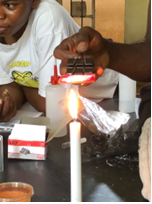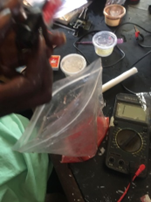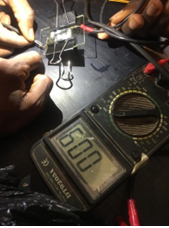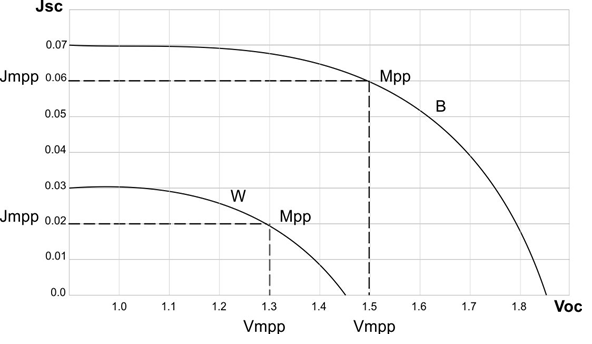Fabrication of Dye Sensitized Solar Cell using Baccate (Berry) and Citrullus Lanatus (Water Melon) as Dye
- Azeez J.
- Kolawole T.
- 105-116
- Feb 5, 2024
- Micronutrient
Fabrication of Dye Sensitized Solar Cell using Baccate (Berry) and Citrullus Lanatus (Water Melon) as Dye
Azeez J.1, 2, Kolawole T.3
1,3Department of Science Laboratory Technology, The Polytechnic, Ibadan.
2PhD Student at African Centre of Excellence in Future Energies and Electrochemical Systems (ACEFUELS), Federal University of Technology, Owerri, Nigeria
Department of Science Laboratory Technology, The Polytechnic, Ibadan. P.M.B 22, U.I. Post Office, Oyo State, Nigeria
DOI: https://doi.org/10.51584/IJRIAS.2024.90109
Received: 08 December 2023; Revised: 31 December 2023; Accepted: 04 January 2024; Published: 05 February 2024
ABSTRACT
The DSSC (dye-sensitized solar cell) is a photo electrochemical solar cell using redox mediator to transport electrons and become an attractive alternative to the widely used Si-based solar cell due to its low processing cost, ease of fabrication, moderate efficiency, and economical friendly. In this work DSSCs were fabricated using berry and watermelon as dye. Our results shows that DSSC with berry have higher efficiency than one with watermelon. The open circuit voltage (Voc), short circuit current, fill factors (FF), maximum power point (PMPP) and efficiency (η) for these cells were obtained and analyzed. The efficiencies for these cells are below prohibitive efficiency and this could be as a result of using ordinary glass because there were no availability of FTO. Further research work is ongoing with the use of FTO and comparative analysis will be carry out.
INTRODUCTION
The DSSC (dye-sensitized solar cell) is a photo electrochemical solar cell using redox mediator to transport electrons and become an attractive alternative to the widely used Si-based solar cell due to its low processing cost, ease of fabrication, moderate efficiency (R. E. Smalley, 2003). In order to improve power conversion efficiency of DSSCs, many attempt have been devoted to modification of the DSSC components such as photo-anode, electrolyte, photo sensitizer, dye molecules and counter electrode (Wang et al., 2011). Among them, the photo-anode modification is of crucial importance in enhancing device efficiency since it works as both photon harvester (by photosensitizer dye) as well as charge transporter.
Dye-sensitized solar cells (DSSCs) have arisen as a technically and economically credible alternative to the p-n junction photovoltaic devices. In the late 1960s, it was discovered that electricity can be generated through illuminated organic dyes in electro chemical cells. At the University of California at Berkeley, chlorophyll was extracted from spinach (photosynthesis). First chlorophyll-sensitized zinc oxide (ZnO) electrode was synthesized in 1972. For the first time, through electron injection of excited dye molecules into a wide band gap of semiconductor, photons were converted into electricity. A lot of research has been done on ZnO-single crystals (Adams, 2006), but the efficiency of these dye-sensitized solar cells was very poor, as the monolayer of dye molecules was able to absorb incident light only up to 1%. Thus, the efficiency was improved by optimizing the porosity of the electrode made up of fine oxide powder, so that the absorption of dye over electrode could be enhanced.
Dye-sensitized solar cells (DSSCs) are regarded as prospective solar cells for the next generation of photovoltaic technologies and have become research hotspots in the PV field. The counter electrode, as a crucial component of DSSCs, collects electrons from the external circuit and catalyzes the redox reduction in the electrolyte, which has a significant influence on the photovoltaic performance, long-term stability and cost of the devices. Solar cells, dye-sensitized solar cells, as well as the structure, principle, preparation and characterization of counter electrodes are important events and development histories of various counter electrodes.
Dye-Sensitized Solar Cell Technology
Dye-sensitized solar cell (DSSC) is one of the most mature technology listed among the emergent alternatives, even though it is already commercially available. Unlike the others, this technology uses liquid electrolyte, although all-solid or quasi-solid states have been also developed. Cell record efficiency is now 12.6% (NREL, 2020). DSSC exhibits lower efficiency, if compared with crystalline silicon cells or some other emerging technologies. Challenges are also related to long term stability and electrolyte leakage.
On the other hand, DSSC benefits from easy and low cost fabrication processes, good efficiency under diffuse and low light intensities, colorful final products and flexible substrates, advantages for buildings integration (C. Gong et al., 2017). DSSC light harvesting is essentially based on light absorption by molecules of dyes anchored to the surface of a semiconductor mesoporous layer, usually nanoparticles of TiO2 (O’regan & Grätzel, 1991). Those dyes are commonly made of synthetic, rare and toxic materials based on ruthenium (Ru), but they can be replaced by plants pigments, which are eco-friendly, low cost, simply extracted and widely available, despite of their still low efficiency and stability (Prabavathy et al., 2017). Those DSSC made of natural dyes are often called natural dye-sensitized solar cells (NDSSC).
Iqbal et al. (J. Iqbal et al., 2019) in their 2019 review brought several published works exhibiting NDSSC efficiencies between 1% and 2%, although most of the publications are still below this range. Exceptionally, Sanjay et al. (Sanjay et al., 2018) could reach 8.22% efficiency from cells made with A. amantacea and P. pterocarpum leaves in ethanol.
Counter Electrodes in Dye-Sensitized Solar Cells
An electrode is a solid electric conductor through which an electric current enters or leaves an electrolytic cell or other medium. An electrode in an electrochemical cell is referred to as either an anode or a cathode (words that were coined by William Whewell at Faraday’s request) (Faraday, 1834). The anode is now defined as the electrode at which electrons leave the cell and oxidation occurs (indicated by a minus symbol, ‘‘’’), and the cathode is defined as the electrode at which electrons enter the cell and reduction occurs (indicated by a plus symbol, ‘‘+’’). For dye-sensitized solar cells, the anode is the electrode on which the metal oxide semiconductor is deposited, and is also called photo-anode, owing to the fact that incident sunlight often comes from here.
The cathode is the electrode on which platinum and other conducting materials are deposited, and is more often called counter electrode, because it exists relative to the anode; a more important reason is that Gratzel first used ‘‘counter electrode’’ in his pioneering paper in Nature in 1991 (Smestad & Gratzel, 1998). In DSSCs, the CE undertakes three functions (M. Gratzel, 1998): (i) as a catalyst, it promotes the completion of process, i.e., the oxidized redox couple is reduced by accepting electrons at the surface of the CE, and process, i.e., the oxidized dye is reduced by collecting electrons via ionic transport materials in solid state DSSCs. (ii) As a positive electrode of primary cells, it collects electrons from the external circuit and transmits them into the cell. Thus the ultimate function of the CE is to return the electrons from the external load back into the ‘‘circulation’’ within the cell. (iii) As a mirror, it reflects the unabsorbed light from the cell back to the cell to enhance utilization of sunlight (C. Gong et al., 2017).
According to these basic functions, an optimal CE should possess the following qualities as required:
- high catalytic activity,
- high conductivity,
- high reflectivity,
- low-cost,
- high surface area,
- porous nature,
- optimum thickness,
- chemical, electrochemical and mechanical stability,
- chemical corrosion resistance,
- energy level that matches the potential of the redox couple electrolyte,
- good adhesitivity with TCO, etc.
LITERATURE REVIEW
Photoanode Substrate
As presented, light must pass through a transparent anode, to reach the active layer formed by the semiconductor layer sensitized by the dye. Thus, plastic and glass substrates are often used. From the plastic side, transparent substrates made of PET (polyethylene terephthalate) are the most common options. For the purposes of the present work, glass substrates with a thin layer of TCO (transparent conductive oxide) were utilized. The most common TCO options for glass substrates are: FTO (fluorine-doped tin oxide) and ITO (indium tin oxide). Qiao et al. (Qiao, 2006) fabricated DSSCs with both options and compared their performances. The group found that FTO exhibits better results, which is in accordance with the regularity that this substrate is chosen by NDSSCs research groups.
Mesoporous Tio2 Nanoparticles Film
DSSC photo-anode is made of a mesoporous layer of semiconductor material which provides an enormous internal surface for the dye molecules to bond (O’regan & Grätzel, 1991). The preferable semiconductor material is titanium oxide (TiO2) because of its high band gap, low cost, abundance, non-toxicity and higher cells efficiency than other materials, like ZnO or SnO2 (Shalini et al., 2015a). TiO2 is commonly used as a paint base in pigment industry (Y. Gong et al., 2017). Also, its conduction band coincides well with the LUMO level of natural pigments (specially with anthocyanin) (Wu et al., 2017).
Cahen et al. (Cahen et al., 2000) explain that the mesoporosity and nanocristallinity of the semiconductor are important not only to achieve a large surface area for dye adsorption, but also to allow the TiO2 particles to become almost completely depleted upon immersion in electrolyte (considering the particles small size), and the proximity to all particles makes screening of injected electrons, and thus their transport, possible.
Thickness
The strategy to determine the most efficient mesoporous film thickness is behind a balance between light harvesting area and necessary diffusion length. If the thickness is increased, the internal surface area of the film will increase and much more dye-molecules can anchor to the surface, harvesting more light. At the same, electrons have a limited diffusion length, which depends on the TiO2 particles diameter, porosity and neck size (C. Gong et al., 2017). If the film is too thick, electrons will not be able to reach the substrate TCO and will be lost. Many authors optimized the cells performance with TiO2 layer thickness below 10μm (Ghann, Kang, Sheikh, et al., 2017).
Ticl4 TREATMENT
The use of titanium tetrachloride to improve DSSC efficiency is becoming more often among researchers. Ghann et al. (Ghann, Chavez-Gil, Goede, et al., 2017) consider it as one of the reasons for the enhanced efficiency achieved by their cells fabricated with pomegranate extracted dye. The explained reason by the authors is the creation of more sites for dye adsorption. This treatment is usually done after TiO2 annealing, dipping substrates in TiCl4 solution for periods of time between 30min to 1h, and then annealing them again. Shirkavand et. at. (Shirkavand et. at., 2018) used TiCl4 40mM aqueous solution at 70ºC for 30min before and after TiO2 sintering steps for the fabrication of DSSC using N719 synthetic dye and blackberry extract.
Dyes
The most often semiconductor oxide used in DSSC is TiO2, a high band gap material, Thus, the light harvesting must be done by dye molecules attached to its surface. The ideal dye should absorb light in all visible wavelength range and has anchoring groups suitable for a firm attachment to the semiconductor oxide (C. Gong et al., 2017).
Due to the high efficiency and stability, ruthenium based dyes, such as N3, N719, N749 and black dyes has been used for TiO2 sensitization since DSSC invention (Shalini et al., 2015a), despite the fact this component is one of the most expensive in DSSC (Y. Gong et al., 2017). Besides, these dyes exhibit other disadvantages: noble metal scarcity, toxic raw materials, and also sophisticated synthesis and purification steps (C. Gong et al., 2017). For these reasons, natural dyes has been studied as a substitute of synthetic dyes.
Natural dyes are environmentally safe, fully biodegradable, non-toxic, easy to prepare, cost effective and widely available (Shalini et al., 2015). TiO2 particles size often used range from 20 to 25μm in diameter, while dye particles size ranges from 1 to 3μm. For the efficient electron injection from the dye molecule to the nanostructure TiO2, it is necessary a strong adsorption. This is achieved via anchoring groups, such as carboxyl, carbonyl and hydroxyl located on the dye molecules (Ghann, Kang, Emerson, et al., 2017). Increasing the number of anchoring groups in the dye enhances sensitization and efficiency, this happens inherently in Kigelia africana due dye composition (Shalini et al., 2015). The better is the bond between dye molecules and TiO2 surface, the better will be the electron injection and the cell overall performance.
In short, some important characteristics that the utilized dye must offer for a good cell performance are listed below (Mohammadian et al., 2018).
- High light absorption in visible range
- Strong interfacial bond with semiconductor
- Easy electrons injection in TiO2 layer (TiO2 CB matching Dye LUMO)
- Quick reduction by redox pair (HOMO lower than redox potential)
Natural dyes can be used to replace the more expensive and toxic synthetic dyes, although efficiency and stability still need improvement for this alternative to be considered. Kumara et. al points several advantages of natural dyes over synthetic ones:
- Simple preparation technique
- Low cost of production
- Complete biodegradation
- High availability
- Purity grade
- Environmental friendliness
Electrolyte
Electrolyte is one of the key components of DSSC because it offers a path for the electrons to regenerate the oxidized dye molecules This component is usually a low viscosity liquid so it can penetrate the porous of TiO2 film and reach all adsorbed dye molecules (Wu et al., 2017). However, extra care must be taken on DSSC sealing to avoid leakage and evaporation (Prabavathy et al., 2017).
Electrolyte working principle is based on a redox pair, usually I – /I3 –. When electrons come to the cathode, in the presence of a catalyst (usually Pt or C), they reduce I3 – ions in the electrolyte to I–, these ions rearrange themselves in the liquid so they can find the oxidized dye molecule attached to the surface of the semiconductor (TiO2), reducing it and become again its oxidized form I3 –.
Iqbal et al. (A. Iqbal et al., 2019) reviewed many studies on NDSSC and indicates several types of electrolytes been used, with different performances and characteristics, such as: LiI, KI, NaI and solid polymers.
Shalini et al. (Shalini et al., 2015) explained that the risk of evaporation and leakage motivated the search for other options of electrolyte under development. One of the mentioned options is polymers consisted of metal salts of low lattice energy dissolved in polymer matrices such as ether, ester or amide, which show advantages such as thermal stability, high ionic conductivity and ease for cell assembly.
Cathode
The presence of Pt or C (graphite) promotes and accelerates the reduction process of the iodine to iodite ion in electrolyte solution (Calogero et al., 2015). Platinum (Pt) is an excellent catalyst to I3 – reduction and has a high back light reflection effect, but on the other hand, it is a rare and expensive material for large scale production. Besides, Pt corrodes with I3 –, generating PtI4 which impacts its durability. Thus, alternatives are being studied, such as: carbon nanotubes, graphite and conductive polymer (Wu et al., 2017).
Ghann et al. (Ghann, et al., 2017) used graphite and considered it as one of the reasons for improving performance. Amadi et al. (Amadi et al., 2012) used carbon soot as catalytic material, passing substrates over a candle light to cover it with a carbon layer.
MATERIALS AND METHOD
Materials
The materials used in the fabrication of dye-sensitized solar cell using berry and water-melon are all listed below in tabular form.
| s/n | NAME OF MATERIALS |
| 1 | Multimeter |
| 2 | Alligator clips |
| 3 | Scotch tape |
| 4 | Pipette |
| 5 | Plastic bottles |
| 6 | Plastic Bag |
| 7 | Pencil |
| 8 | Binder clips |
| 9 | FTO Glass |
| 10 | Titanium dioxide paste |
| 11 | Iodide Electrolyte |
| 12 | Berry |
| 13 | Weighing balance |
Method
The procedures in carrying out the fabrication of dye-sensitized solar cells using berry and watermelon are listed below in sequence.
- Preparing the Tio2 Electrode
- One part of the glass substrate was used as the conductive layer and the scotch tape was used to cover the other edges of the glass.
- The TiO2 powder was converted to paste by gently mixing with water, and a couple of drops was deposited onto the glass substrate using pipette.
- The smooth layer of the pipette was used to make a thin layer of the paste round the surface of the glass. It was then left to dry for several minutes.
- After drying, the tape was peeled off carefully and placed under a heat source.
- After several minute, it was allowed to cool.
Fig 3.1: Prepared FTO Glass under a heat source
- Preparing The Dye
- About three berries was placed inside the plastic zip-lock bag and was gently crushed to release its juice.
- A little drops of water was added to make the dye (squashed berry) juicer.
- The TiO2 coated glass was then added to the juice and made sure it was completely covered with the dye. It was then set aside for few minutes.
Fig 3.2: The squashed water-melon to form dye.
- Preparing The Counter Electrode
- Another glass substrate was obtained and a pencil was used to make a shading round the conductive part of the glass.
- The previous glass that was kept in the dye was removed and rinsed with water and allowed to dry
- Assemble The Dssc
- The two glasses were placed in which the coating sides were facing each other.
- A binder clip was placed on the edge of the glasses to clip it together.
- Small amount electrolyte was added in between the edges of the glass using the pipette.
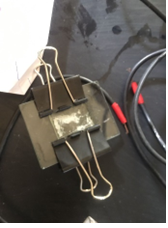
Fig 3.3: The Fabricated DSSC
- Testing The Dssc
- The Multimeter was set to measure voltage, and the alligator clips was attached to the Multimeter probes in order to make contact with the glass.
- The other end was attached to the overhanging glass on the each side.
- The voltage of the DSSC started reading on the Multimeter screen, it was tested with light and without light.
- The same procedure was observed for testing the current and the readings were observed and recorded.
RESULTS AND DISCUSSION
Results
Table 4.1: Result for DSSC with berry
| S/N | ISC (mA)
Short circuit current |
VOC (volts)
Open circuit voltage |
JSC (mA/cm2)
JSC = ISC/A |
DSSCs operation mode |
| 1 | 3.30 | 2.60 | 0.132 | With Sunlight |
| 2 | 0.20 | 1.12 | 0.008 | Without sunlight |
| Average = 1.86 | Average = 0.07 |
A = Area of the deposited TiO2 nanoparticle on the FTO glass
L = 5cm B = 5cm
A = 5 x 5 = 25cm2
Table 4.2: Result for Watermelon
| S/N | ISC (mA)
Short circuit current |
VOC (volts)
Open circuit voltage |
JSC (mA/cm2)
JSC = ISC/A |
| 1 | 1.02 | 1.80 | 0.041 |
| 2 | 0.30 | 1.09 | 0.012 |
| Average = 1.45 | Average = 0.03 |
Maximum Power Point
Fig 4.1 J-V curve DSSC with dye extracted from Berry and watermelon
Calculations For Berry
PMPP (Maximum power point) = JMPP x VMPP
PMPP = 0.06 x 1.5 = 0.09
FF (Fill factor)
= (0.06 × 1.5)/(1.86 ×0.07)
Fill factor = 0.69%
η (Efficiency) = (VOC × JSC ×FF)/100
= (1.86 × 0.07 × 0.69)/100
η (Efficiency) = 0.0009%
Calculations For Watermelon
PMPP (Maximum power point) = JMPP x VMPP
PMPP = 0.02 x 1.3 = 0.026
FF (Fill factor) = (JMPP × VMPP)/(VOC × JSC )
= (0.02 × 1.3)/(1.45 ×0.03)
Fill factor = 0.04%
η (Efficiency) = (VOC × JSC ×FF)/100
= (1.45 × 0.03 × 0.04)/100
η (Efficiency) = 0.00002%
Table 4.3: Final tabled result for Berry
| S/N | ISC (mA)
Short circuit current |
VOC (volts)
Open circuit voltage |
JSC (mA/cm2)
JSC = ISC/A |
PMPP (Watts) | FF | η |
| 1 | 3.30 | 2.60 | 0.132 | 0.09 | 0.69% | 0.0009% |
| 2 | 0.20 | 1.12 | 0.008 | |||
| Average = 1.86 | Average = 0.07 |
Table 4.4: Final tabled result for watermelon
| S/N | ISC (mA)
Short circuit current |
VOC (volts)
Open circuit voltage |
JSC (mA/cm2)
JSC = ISC/A |
PMPP (Watts) | FF | η |
| 1 | 1.02 | 1.80 | 0.041 | 0.026 | 0.04% | 0.00002% |
| 2 | 0.30 | 1.09 | 0.012 | |||
| Average = 1.45 | Average = 0.03 |
Discussion
By the conclusion of the present work it was possible to achieve the initial goals with important learnings and findings. The fabrication was carried out using the berry and watermelon as dye, one of the most important pigments present in blackberry fruits is anthocyanin which is of great interest for DSSC fabrication.
After the preparation, current (ISC) and voltage (VOC) was tested in two different ways with light and without light. Without light was achieved by using the hand to cover the deposited area on the FTO glass so as to block light ray from penetrating. After getting the results, it was noticed that the voltage and current reduced when there was absence of light.
Short circuit current density was gotten by dividing the current by the Area of the deposited site on the FTO glass, and a graph of JSC against VOC was plotted so as to get the voltage at maximum power point (VMPP) and current at the maximum power point (JMPP). The addition of both (VMPP and JMPP) result to the power generated at the maximum point, the fill factor (FF) and efficiency (η) was also gotten from the parameters available.
After getting the results of the calculations, the efficiencies of both fruit was low which was believed to be as a result of the inefficient fruit which might have been contaminated. It was seen that the berry solar cell is more efficient than the watermelon having a higher efficiency than that of watermelon, In the future, further development and optimization for this fruit dye can offer even better results.
It is hoped that other researchers and institutions can benefit from the present work, not only by its findings but as an incentive for others to join an even greener PV energy generation. This journey is just beginning!
CONCLUSIONS AND RECOMMENDATION
Conclusions
DSSCs using berry and watermelon were fabricated and our results showed that one with berry is having higher efficiency. But the efficiencies of the two cells are below prohibitive efficiency and this could be as a result of the use of ordinary glass substrate instead of FTO.
Recommendation
Further research work is recommended on the use of FTO instead of ordinary glass substrate and the source of dye needs to be clean and verified.
REFERENCES
- Adams, W. M. (2006). The future of sustainability: Re-thinking environment and development in the twenty-first century.
- Amadi, L., Jenny, S. S., Ahmed, A., Brown, N., Yadav, S., Brown, D., Ghann, W., Gayrama, A., Jiru, M., & Uddin, J. (2012). Creation of Natural Dye Sensitized Solar Cell by Using Nanostructured Titanium Oxide. 9.
- Cahen, D., Hodes, G., Graetzel, M., Guillemoles, J. F., & Riess, I. (2000). Nature of photovoltaic action in dye-sensitized solar cells. The Journal of Physical Chemistry B, 104(9), 2053–2059.
- Calogero, G., Bartolotta, A., Di Marco, G., Di Carlo, A., & Bonaccorso, F. (2015). Vegetable-based dye-sensitized solar cells. Chemical Society Reviews, 44(10), 3244–3294.
- Faraday, M. (1834). VI. Experimental researches in electricity.-Seventh Series. Philosophical Transactions of the Royal Society of London, 124, 77–122.
- Ghann, W., Chavez-Gil, T., Goede, C. I., Kang, H., Khan, S., Sobhi, H., Nesbitt, F., & Uddin, J. (2017). Photophysical, electrochemical and photovoltaic properties of porphyrin-based dye sensitized solar cell. Advances in Materials Physics and Chemistry, 7(5), 148–172.
- Ghann, W., Kang, H., Emerson, E., Oh, J., Chavez-Gil, T., Nesbitt, F., Williams, R., & Uddin, J. (2017). Photophysical properties of near-IR cyanine dyes and their application as photosensitizers in dye sensitized solar cells. Inorganica Chimica Acta, 467, 123–131.
- Ghann, W., Kang, H., Sheikh, T., Yadav, S., Chavez-Gil, T., Nesbitt, F., & Uddin, J. (2017). Fabrication, optimization and characterization of natural dye sensitized solar cell. Scientific Reports, 7(1), 1–12.
- Gong, C., Li, L., Li, Z., Ji, H., Stern, A., Xia, Y., Cao, T., Bao, W., Wang, C., & Wang, Y. (2017). Discovery of intrinsic ferromagnetism in two-dimensional van der Waals crystals. Nature, 546(7657), 265–269.
- Gong, Y., Luo, H., & Zhang, J. (2017). Natural language inference over interaction space. ArXiv Preprint ArXiv:1709.04348.
- Iqbal, A., Mukherjee, M., Rashid, J., Khan, S. A., Ali, M. A., & Arshad, M. (2019). Development of plant-microbe phytoremediation system for petroleum hydrocarbon degradation: An insight from alkb gene expression and phytotoxicity analysis. Science of the Total Environment, 671, 696–704.
- Iqbal, J., Abbasi, B. A., Batool, R., Khalil, A. T., Hameed, S., Kanwal, S., Ullah, I., & Mahmood, T. (2019). Biogenic synthesis of green and cost effective cobalt oxide nanoparticles using Geranium wallichianum leaves extract and evaluation of in vitro antioxidant, antimicrobial, cytotoxic and enzyme inhibition properties. Materials Research Express, 6(11), 115407.
- Mohammadian, J., Shirkavand Hadavand, B., & Khajenoori, S. (2018). Synthesis and investigation on viscoelastic properties of urethane acrylate-polyaniline. Progress in Color, Colorants and Coating (PCCC), 11(4), 241–252.
- O’regan, B., & Grätzel, M. (1991). A low-cost, high-efficiency solar cell based on dye-sensitized colloidal TiO2 films. Nature, 353(6346), 737–740.
- Powell, C. E., & Qiao, G. G. (2006). Polymeric CO2/N2 gas separation membranes for the capture of carbon dioxide from power plant flue gases. Journal of Membrane Science, 279(1–2), 1–49.
- Prabavathy, N., Shalini, S., Balasundaraprabhu, R., Velauthapillai, D., Prasanna, S., & Muthukumarasamy, N. (2017). Enhancement in the photostability of natural dyes for dye-sensitized solar cell (DSSC) applications: A review. International Journal of Energy Research, 41(10), 1372–1396.
- R. E. Smalley, 2003—Google Scholar. (n.d.). Retrieved July 16, 2022, from https://scholar.google.com/scholar?hl=en&as sdt=0%2C5&q=R.+E.+Smalley%2C+2003&btnG=
- Sanjay, M. R., Madhu, P., Jawaid, M., Senthamaraikannan, P., Senthil, S., & Pradeep, S. (2018). Characterization and properties of natural fiber polymer composites: A comprehensive review. Journal of Cleaner Production, 172, 566–581.
- Shalini, S., Prasanna, S., Mallick, T. K., & Senthilarasu, S. (2015a). Review on natural dye sensitized solar cells: Operation, materials and methods. Renewable and Sustainable Energy Reviews, 51, 1306–1325.
- Shalini, S., Prasanna, S., Mallick, T. K., & Senthilarasu, S. (2015b). Review on natural dye sensitized solar cells: Operation, materials and methods. Renewable and Sustainable Energy Reviews, 51, 1306–1325.
- Shirkavand et al., “The Construction and Comparison of Dye-Sensitized Solar Cells with Blackberry and N719 Dyes”, Journal of Optoelectronical Nanostructures Vol. 3, No. 1, 2018.
- Smestad, G. P., & Gratzel, M. (1998). Demonstrating electron transfer and nanotechnology: A natural dye-sensitized nanocrystalline energy converter. Journal of Chemical Education, 75(6), 752.
- Wang, S.-W., Lee, J.-K., Ku, C.-C., Chiou, S.-S., Steve Lin, C.-L., Ho, M.-F., Wu, D.-C., & K Yokoyama, K. (2011). Jun dimerization protein 2 in oxygen restriction; control of senescence. Current Pharmaceutical Design, 17(22), 2278–2289.
- Wu, D., Jennings, C., Terpenny, J., Gao, R. X., & Kumara, S. (2017). A comparative study on machine learning algorithms for smart manufacturing: Tool wear prediction using random forests. Journal of Manufacturing Science and Engineering, 139(7).

